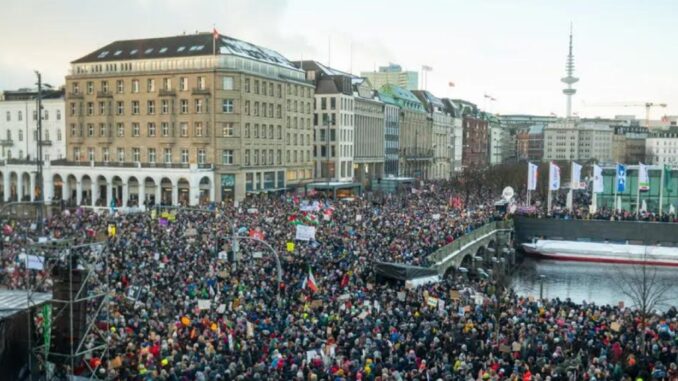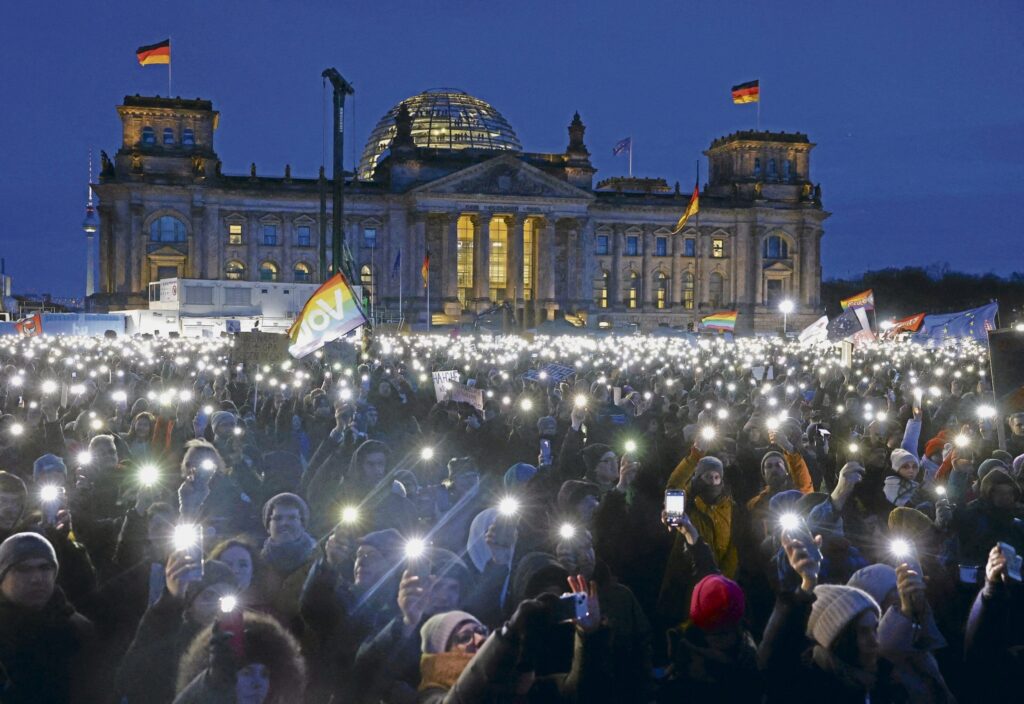
During the last few days, more than one and a half million people demonstrated in Berlin, Hamburg, Munich and 40 other cities in the country against racism, xenophobia of the far-right party Alternative for Germany (AfD) and against the expel migrants’ policy.
By Carolina Menéndez Trucco
Under the motto «Never again 1933», in reference to the arrival of the Nazi regime and the similarities of the policies promoted by the extreme right today, almost a million people took to the streets to protest against the danger that represents the extreme right and its supporters in politics. Although the mobilization process takes several days, the epicenter of the call was on Sunday, January 21, when the street action broke all records in the country’s recent history. Since it became known that the AfD, together with other far-right and ultra-conservatives, were seeking to promote a program of mass deportations, there was an increasingly massive wave of protests that even brought together Chancellor Olaf Scholz, of the German Social Democratic Party, and the Minister of Foreign Affairs, Annalena Baerbock, of the Greens during the “Potsdam defends itself” mobilization in the capital of Brandenburg on Sunday the 14th.
A week later the impact spread. The largest demonstrations took place on Sunday the 21st in Berlin with 350,000 participants and in Munich with up to 250,000 according to the organizers, and on Saturday the 20th in Hamburg with 250,000, in Frankfurt am Main with 35,000 and Dortmund with 30,000 protesters. The actions in Munich and Hamburg were prematurely broken up by the police due to the large crowds. More anti-right marches were recorded on Monday night, for example in Bayreuth, Freiberg (Saxony) and Paderborn (North Rhine-Westphalia). Among the banners seen in the marches in Berlin, Leipzig, Hamburg, Essen, Cologne or Rostock, one could read phrases with allusions to Hitler’s Germany such as: “Voting for the AfD is so 1933”; “Now we can do it better than our grandparents”; “There is no place for Nazis” or “Human rights instead of right-wing humans.”

Two demonstrations in less than a week took place in Cologne: some 30,000 people flooded the city on Tuesday the 16th and another 70,000 on Sunday the 21st at the Deutz shipyard. Bremen also stood up strongly. More than 45,000 people took to the streets as part of the “Loud against the right” demonstration, exceeding all the organizers’ expectations. The large turnout at the protest was a huge show of strength for the smallest of Germany’s 16 federal states. Members of the Salidarnast Association, which includes union leaders and supporters of the ISL of Belarus, also participated in the march. In the German capital, the protest was called by parties, different organizations and unions under the slogan “Defend democracy: together against the right.”
Protests against the strengthening of the AfD continue to spread. Hundreds of thousands of people came for the third weekend to demonstrate against the extreme right. On Sunday the 28th, a mobilization was held in Hamburg under the motto “For diversity and our democracy – Hamburg united against the AfD.” About 100,000 people marched through the city in the north of the country, while, in the western city of Düsseldorf, about 100,000 protesters also took to the streets again, as in many other cities.
Adulterated video, but well used…
“At the latest after this week with more than 1.5 million protesters, the Federal Chancellor’s task is clear: Get the Nazis off our backs!” published the Center for Political Beauty (Zentrum für Politische Schönheit) on Sunday, January 21, on networks along with a video that had a great impact and generated controversy.
At the anti-AfD demonstration that Sunday in Berlin, tens of thousands of people stood in front of the Reichstag, forming a sea of lights in the darkness. Some voices could also have been heard chanting: “Hey, get involved, defend yourself, resist fascism here in the country.” But the Center for Political Beauty is not the author of the video nor who documented the songs. The original video was recorded by the SPD[1] parliamentary group and then distributed by the Center for Political Beauty (Zentrum für Politische Schönheit). Added to that the original song heard in the Berlin video comes from a demonstration against the extreme right in Leipzig on January 15.
All in all, since the song would have been sung at the Berlin demonstration and reflects the anti-fascist spirit of the marches, for many it was not wrong to give a different tone to the video, it’s just that the Center for Political Beauty should have clarified that the video and the audio did not go together. Its viralization expresses a strong popular rejection of the extreme right.
Huge blow to the far right
The protests were triggered by information revealed by the investigative media Correctiv about a previously unknown meeting that right-wing extremists had on November 25 in Potsdam. The meeting was attended by several AfD politicians, as well as members of the Identitarian Movement and the very conservative Union of Values group (Werteunion). In a country where the far-right Alternative for Germany has been strongly strengthening itself in the polls, is running as it is running as a government option and exerts influence on government policy, these marches are an enormous demonstration of strength by a large part of the German people who reject actively the presence and consolidation of the radical right. In fact, its own growth in Germany is closely linked to the right-wing policies carried out by the coalition government that, while on the one hand participates in the mobilizations, on the other puts its same anti-immigrant policies into practice. The Scholz cabinet contributes to the rise of fascism not only by ensuring a worsening of entry conditions for immigrants and their budget cuts in aid, but also by passing a law so that they can be quickly deported again (the Repatriation Improvement Act recently sanctioned). In other words, the racism, xenophobia of the AfD and the policies of expulsion of immigrants have led to the consequent wave of demonstrations in their repudiation. At a time when the right and the extreme right are growing in many countries, it is important to highlight that this regressive phenomenon is not all-powerful, there is polarization and hundreds of thousands of young people, workers and middle sectors are mobilizing to repudiate these policies in the streets. It is a democratic struggle to continue in Germany and throughout the world with a revolutionary and socialist strategy, because as long as capitalism continues to exist, and even more so because it is in decline, it will continue to engender dangerous fascist tendencies.
[1] Social Democratic Party of Germany (Sozialdemokratische Partei Deutschlands). Since December 2021, presides over the federal government with Chancellor Olaf Scholz, with Alliance 90/The Greens and the Free Democratic Party (FDP) as coalition partners.








